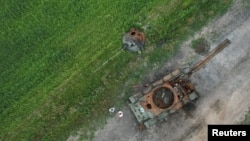On May 15, Russian President Vladimir Putin’s appointee in Chechnya, Ramzan Kadyrov, posted a video on his Telegram channel showing him atop a Russian T-72 tank. Russian state news agencies reported Kadyrov’s social media post amplifying his claim that the T-72 is superior to the American Abrams:
"The Abrams? Heh! A children's pedal car, your Abrams. Here’s the real power! An upgraded T-72! ... Surpasses foreign equipment in combat power, control, protection and ease of operation … On such a tank we will enter Kiev and carry out denazification, simultaneously splitting the Abrams like nuts! Wait!
That claim is false.
According to most military experts, American Abrams tanks are superior to the Russian T-72s. In a historic tank battle during the 1991 Gulf War, a U.S. brigade of Abrams tanks annihilated an Iraqi brigade of T-72s in less than an hour.
This past January, the United States pledged to supply Abrams tanks to Ukraine as a way of enhancing the Ukrainian military’s armored capabilities against Russian forces.
The T-72 and Abrams are among the world's most widely known and used main battle tanks. The Soviet Army developed the T-72 from 1967 to 1973, the year it introduced the tank into service. The Abrams has been mass-produced since 1980 and is the main U.S. battle tank.
Russia’s own military analysts admit the U.S. Abrams tanks' superiority to T-72s.
For example, Ruslan Pukhov, director of the Center for Analysis of Strategies and Technologies, a Russian think-tank, told the Russian newspaper Moskovsky Komsomolets that “M1A2 Abrams tanks are the best tanks in the world” in terms of combat potential, surpassing the Russian T-90 tanks, which are the newest and most advanced version of the T-72.
"Even in export versions, the Abrams M1A2 SEP v.2 variant significantly outperforms any Russian production tank (the newest is the T-90M; the [even newer T-14] Armata has not yet gone into large-scale production), as well as outperforms German tanks of the Leopard 2 family," Pukhov said.
According to Army Recognition, a Belgium-based military news website, “[t]he M1A1 Abrams was initially developed... to counter the threat of Soviet-era T-72s.” The T-72’s armor and fire control systems, it says, are “less advanced compared to the M1A1 Abrams, making it more vulnerable to enemy fire.”
The M1A1 Abrams tanks were produced from 1986 to 1992. The M1A2 Abrams, with its technical advancements, was approved for production in 1990.
Armor
Abrams tanks have advanced Chobham composite armor that provides superior protection against anti-tank munitions. The Abrams can also be optionally equipped with reactive armor or active protection systems. The T-72 has weaker steel and composite armor and has more limited options for armor upgrades.
Firepower and mobility
The Abrams’s 120mm smoothbore cannon provides greater accuracy and armor penetration than the T-72's 125mm smoothbore cannon. The Abrams also has a more advanced fire control system, which provides faster target detection and an increased probability of hitting a target with the first shot. Another advantage of the Abrams is its ability to fire projectiles made of depleted uranium, which is denser than other materials traditionally used in armor-piercing projectiles.
Thanks to a more powerful gas turbine engine, the Abrams has better acceleration and maneuverability than the T-72.
Optics and protection
The T-72’s optics and night vision systems are inferior to those of Abrams tanks, which are equipped with improved optics, thermal imaging and night vision capabilities. This allows an American tank crew to more effectively detect targets and engage them in various lighting and environmental conditions.
Crew comfort and protection also is better in the Abrams, which has an enlarged fighting compartment that provides more space and comfort. Thanks to the blowout panels, the Abrams’ ammunition storage system reduces the risk of a catastrophic ammunition explosion if the tank is penetrated.
In comparison, as The Washington Post noted, the T-72 has a deadly design flaw: shells are placed in a circle inside the tank’s turret. When an enemy shot hits the tank, there is a high probability of a chain reaction occurring - the ammunition detonates and blows off the turret, killing everyone inside.
The force of such a detonation can “instantly vaporize” a T-72 tank crew, according to Robert Hamilton, a professor at the U.S. Army War College.
Communications
The Abrams has a more sophisticated communications and networking system, which facilitates coordination and integration with other units.
According to Michael Clarke, a professor in the War Studies department of King's College London, the Abrams surpasses the T-72 in all key areas.
“Looking at the weight, speed, armored protection, sighting technology, and accuracy, to name just a few, the M1 Abrams outclasses the T-72 variants,” he told Newsweek.
Record in combat
During the Gulf War, U.S.-led coalition forces fought an Iraqi army armed with T-72s, making it possible to compare the battlefield capabilities of Soviet and American tanks, including the M1A1 Abrams.
“It would go down as the largest battle of Operation Desert Storm, yet it wasn’t much of a fight,” the U.S. military's Stars and Stripes newspaper reported in 2016.
“Tankers with U.S. Army’s 2nd Brigade, 1st Armored Division, needed a mere 40 minutes to pulverize an armored brigade of the Iraqi Republican Guard during the Battle of Medina Ridge, a display of technological superiority against a force many expected to be more formidable.”





